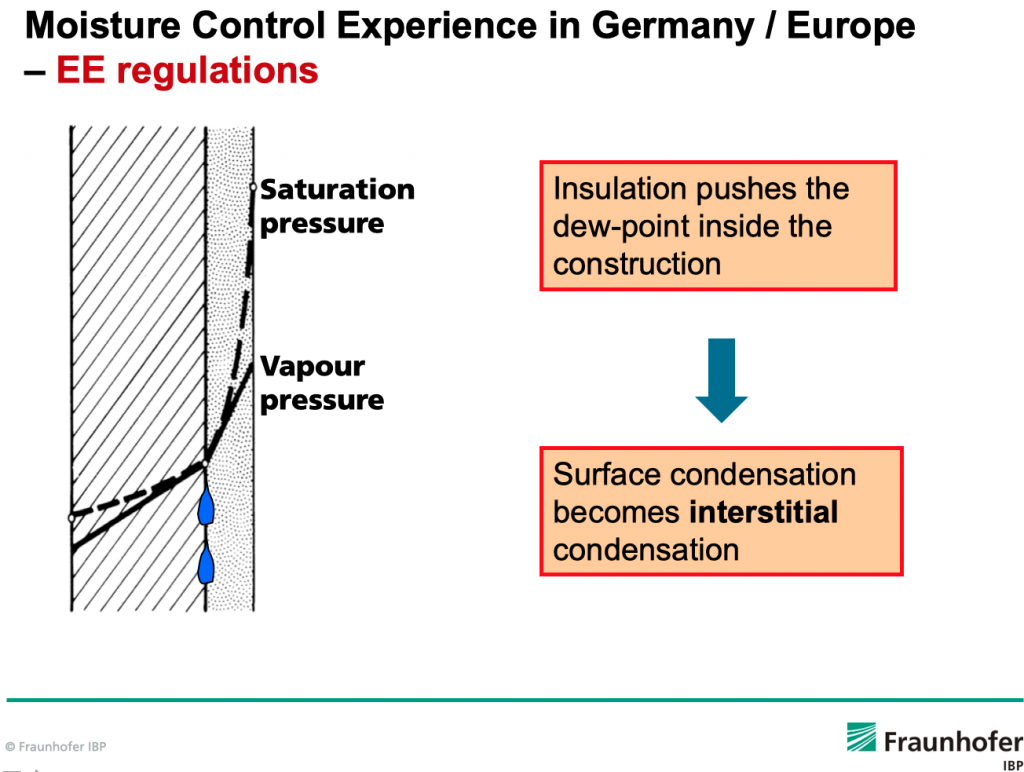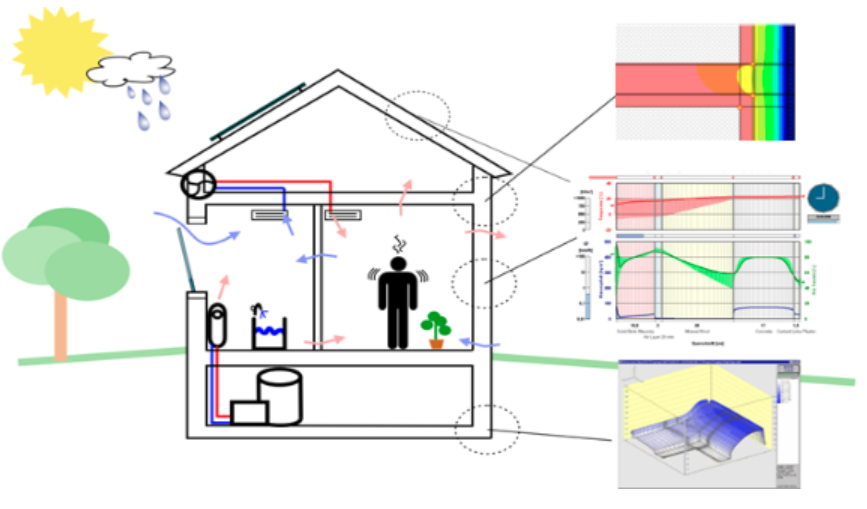Podcast: Play in new window | Download | Embed

When Prof. Dr. Hartwig Künzel was studying Chemical Engineering, his father was a scientist at the Fraunhofer Institute. Hartwig followed in his father’s footsteps after becoming interested in the preservation of heritage buildings. Prof. Künzel soon discovered that he could apply his engineering training to diagnosing the moisture problems that occurred after buildings were insulated.
Fraunhofer Institute
The Fraunhofer Institute is an independent, not-for-profit research organisation. They undertake private research as well as government and European Union contracts. The organisation is made up of 66 separate institutes covering a wide range of scientific disciplines. Hartwig is the Head of Department Hygrothermics at the Fraunhofer Institute for Building Physics IBP.

Making Buildings Comfortable
Europe has a lot of old, beautiful buildings and Hartwig feels that it’s important for them to be preserved. For this to happen, Hartwig says we need to ‘use them or lose them’ and they need to be made comfortable for people to want to use them.
Making buildings comfortable requires insulation. This is just as true for our new buildings as it is for old heritage buildings in Europe. And just like old buildings in Europe, we need to be aware of what happens when we add insulation.
The Problem with Insulating
“Insulating a building is a game changer”, says Hartwig. “People don’t realise it because they don’t see it. “An insulated wall looks like an uninsulated wall, but it behaves completely differently.
We insulate to get the benefits of comfort and energy efficiency. But insulation can cause a lot of problems if you do it wrong.
An insulated building can get wet faster and it can take longer to dry out.
Increased Temperature Gradient
The first problem with insulating a building is that the insulation introduces a temperature gradient. This means that the insulation creates a big difference between the internal surface and the external surface, which is a good thing for comfort. A temperature gradient however is a driving force for moisture.

Moisture will always go towards the cold side. When both sides of the wall are similarly cold, as in an old, cold, uninsulated building, neither heat nor moisture is moving through the wall.
Insulating a wall is like tilting a table tennis table with a ball sitting on it. Tilting the table makes the ball move. Insulating a wall tilts the vapour pressure and makes moisture move.
Reduced Drying Potential
Insulation material in a wall also reduces the drying potential of that wall. Some materials can act a bit like a sponge.
Reduced drying potential means that it’s harder for the wall to dry out, so it stays wet for longer.
Vapour Control Layer
A vapour control layer is part of the solution for avoiding the moisture problems that can occur when insulation is added to a building. To understand how this works, it’s helpful to understand a bit about water vapour.
Water Vapour
Water vapour is different from steam.
Steam is visible. We can see it. This is because steam is made up of lots of tiny droplets of liquid water. Steam is clumps of water molecules that have condensed (stuck together to form a water droplet). This is the same as fog. (Fog can be seen so much, that it causes a problem when you can’t see through it!)
Water vapour, on the other hand, is an invisible gas. We can’t see vapour. We can only see the result of vapour condensing on a cold surface, like drops of water on the outside of a cold beer.
Most Building Materials are Porous
Porous materials let water through and most building materials are porous. Only modern materials like heavy polythene and foil are non-porous. We call these a ‘vapour barrier’.
But here’s the bit that confused me for some time. A material can be porous (let water through), but airtight. This is because water vapour molecules are smaller than air molecules. As Hartwig puts it, a water vapour molecule “… can get almost anywhere.”
Diffusion
Diffusion is the movement of something from a place where there’s lot of that thing (a high concentration) to somewhere where there’s not much of it (a low concentration).
The size of molecules determines what can pass through a material, or not. But water, air, or anything else won’t move through something just because it can. Things need a reason to move. Which brings us back to the tilting table and vapour drive.
With insulation in a wall, we set up a condition where there’s a difference in temperature from one side to the other. We’ve effectively tilted the table. With a difference in temperature comes a difference in relative humidity and this causes vapour molecules to want to move.
Interstitial Condensation
Vapour molecules moving through a building element is not a huge problem as long as the molecules can move all the way through. But a couple of things can happen along the way. One is that the vapour gets stopped by a barrier (which is why plastic or foil in a wall is not usually a good idea). The other is that the molecules reach a point where the temperature is cool enough for the condensation to occur. If this happens, we get wetness inside the wall which is referred to as ‘interstitial condensation‘.
When interstitial condensation hangs around long enough, it create a good environment for mould to grow and that’s when our buildings start to make us sick.
Warm and Healthy Buildings

We don’t want to stop insulating our walls, roofs and floors. We need our buildings to have the ability to keep us warm. Therefore we need to understand the effects of insulation and how to manage moisture in order to reduce or eliminate the risk of interstitial moisture.
Tools like WUFI® allow us to do just this.
WUFI®
Hartwig and his team already had tools for calculating vapour diffusion in relatively simple, steady state conditions. But for his work on heritage buildings, they also needed to account for driving rain and changing conditions.
Steady state calculations are fine when the conditions on each side of a wall are constant. This isn’t the case for buildings. We have daily changes in temperature, humidity and pressure on the outside because of weather and climate. And we have changes on the inside due to people.
Incorporating his experiences from studying in the Manchester and Paris, Hartwig started to develop a dynamic hygrothermal modelling tool as part of his PhD. This tool became WUFI®.
WUFI® now has a dedicated team of about 10 people working on the software suite at Fraunhofer and a global user base in the thousands.
Is New Zealand Special?
Hartwig has benefitted from networking with scientific colleagues around the world including the United Kingdom, France, and the United States. He’s a big advocate for sharing learning and for adapting ideas to local conditions.
New Zealand is special, but not in a lot of ways that we think. There are cities around the world with very similar climates to the main centres in New Zealand. The same is true for Australia.
Regardless of where you happen to be in the world, the laws of physics remain the same. So a tool like WUFI® is as relevant and useful here as it is anywhere.
BRANZ have already been collaborating with the Fraunhofer Institute for many years and we have experts like Jesse Clarke, Technical Manager for Pro Clima Australia working on increasing the uptake of hygrothermal modelling in the Southern Hemisphere.
Now we just need to get more people asking for hygrothermal analysis, and local product suppliers to provide material data.
Presentations and Training
Presentation slides and videos from Hartwig and Jess Clare area available on the pro clima HUB website. Keep an eye out for upcoming WUFI® training so you can be part of the solution for creating a better place to live!

Leave a Reply